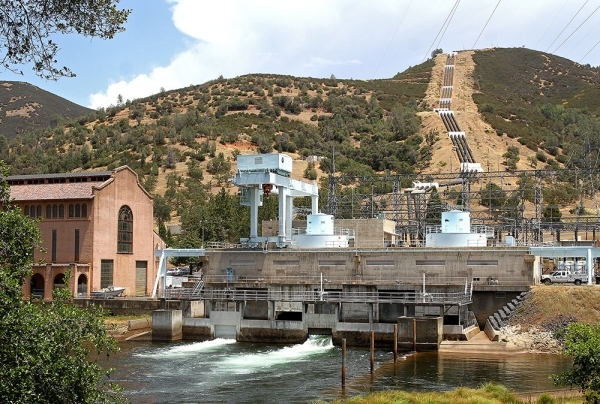It's a treasure that is all too easy for Palo Alto to take for granted — an abundant supply of pristine water that flows from the Sierra Nevada snowpacks and passes through the Hetch Hetchy system before splashing out of local showers and faucets.
But while the water is famously clear, the process by which it gets here can be a bit opaque. Palo Alto is one of 26 cities that belong to the Bay Area Water Supply and Conservation Agency (BAWSCA), which manages the member cities' supply agreement with the San Francisco Public Utilities Commission. Like all other partner agencies, Palo Alto gets its contractual allocation of water and pays its share for the water supply and for capital improvements to the aged water system.
Even so, the cities don't always know which projects they're helping to fund. The San Francisco Public Utilities Commission, which is now completing a $4.8-billion capital project known as Water System Improvement Program (WSIP), has been unilaterally adopting its capital plans, with little involvement from the partners who help pay for the myriad projects in these plans. These days, as the 26 cities in BAWSCA are revising their water contract with the SFPUC, one of their key goals is to change that.
Over the course of the negotiations, the two agencies have agreed to adopt seven amendments to their 1984 agreement, according to Nicole Sandkulla, chief executive officer and general manager of BAWSCA. The SFPUC signed off on the changes last December. Now, each BAWSCA city is reviewing these changes, with the Palo Alto City Council set to consider them this Monday, March 4. This is the second time that the 1984 agreement will be amended (the first amendment came in 2009).
One amendment in the new agreement would give BAWSCA cities more oversight of the SFPUC's 10-year capital improvement program. While the SFPUC would still have the final say on its projects, the agreement requires the SFPUC to hold quarterly meetings with BAWSCA to present detailed information about each individual project in its program and about any potential "candidate" project. The SFPUC will also be required to "formally engage" with BAWSCA as it develops its 10-year capital improvement program.
In her Feb. 6 presentation to the Utilities Advisory Commission, Sandkulla described the SFPUC as an "unregulated monopoly" that doesn't report to any other agency.
"But they are prideful and a public process has proven to be very effective in getting them to do what you want them to do," Sandkulla said. "That's what this amendment is trying to take advantage of — getting inside, getting enough information so that we can either impact the decision before it gets to their commission or, if not, to be educated and smart enough to be able to affect the discussion publicly."
Under the new agreement, the SFPUC will also be required to respond, in writing, to all written comments submitted by BAWSCA and wholesale customers on the 10-year plan before the agency's first budget meeting. And it will have to give wholesale customers the opportunity to review and provide comment on "any changes to the level of service goals and objectives" that the commission may be considering.
Lisa Bilir, a resource planner at the Utilities Department, told the commission on Feb. 6 that the amendment will ensure that "BAWSCA and wholesale customers are involved in developing the 10-year capital improvement program and have the opportunity to comment on proposed changes to the water supply and delivery targets."
"This will give BAWSCA and wholesale customers the ability to oversee and scrutinize the SFPUC's capital program, which is a major factor in the resulting rates," Bilir said.
Other amendments aim to update outdated policies, correct flawed ones and clear up confusion over classification of numerous SFPUC assets — a factor that can influence rates for water customers in Palo Alto and other BAWSCA cities. Hetch Hetchy facilities are currently classified as "water," "power" or "joint" (which have both water and power benefits) assets. BAWSCA's wholesale customers are exempt from paying for power-related facilities, however, they do pay for 45 percent share of the "joint" assets.
According to a report from the Utilities Department, the amendment aims to address a decision by the SFPUC to unilaterally reclassify several assets from "power" to "joint," a move that added $50 million in obligation to water customers. BAWSCA challenged that decision and ultimately reached an agreement with the SFPUC to reclassify seven specific projects and to "fix" the reclassification of all Hetch Hetchy assets, according to utilities. The amendment also removes the $50 million of obligation from the wholesale customers, ensuring the customers will only be required to pay their fair share for the $2 billion in capital work that the SFPUC plans to undertake over the next 10 years, according to utilities.
"It is in the Wholesale Customers' interest to provide SFPUC the revenue needed to fund these annual repair and maintenance projects while ensuring the Wholesale Capital Fund is kept at a reasonable level," the Utilities Department staff report states. "The proposed amendment achieves those goals."
The new agreement also includes amendments that would formally memorialize the "supply assurance" to the wholesale customers, which is set at 184 million gallons per day (each customer also has its "individual supply guarantee"); updates the completion date of the WSIP effort (from the outdated date of Dec. 31, 2015 to Dec. 30, 2021); and creates an annual reconciliation process for capital funds that wholesale customers contribute to the SFPUC to ensure that the agency has the necessary resources for needed improvements.
Another amendment in the new agreement modifies how water is allocated during drought periods. The change, according to utilities staff, will allow more water to be available to wholesale customers during drought periods than under the existing agreement. The staff report notes that had the current formula been applied during the 2014-2017 drought, San Francisco's retail customers would actually have been allocated more water than they would have received during years with typical rainfall.
This amendment, according to utilities staff, benefits the city by "ensuring a more equitable allocation of water during a water shortage resulting from drought."
The Utilities Advisory Commission voted 6-0, with Arne Ballentine absent, on Feb. 6 to support the amended agreement. The council is expected to approve the changes on its "consent calendar," which is reserved for non-controversial items, this Monday.




Comments
Another Palo Alto neighborhood
on Mar 2, 2019 at 11:10 am
on Mar 2, 2019 at 11:10 am
Why don't our municipalities have to be realistic about water and growth? Why do existing residents who sacrificed for decades to be here have to suffer while developers can use all the water they want and add as many people for the benefit of companies that really should move somewhere more sustainable to grow? (Multiply the number of innovation centers!). I spent decades working toward having a garden, which is my most beloved pasttime, only to have to let it die for the drought, while up the street, a developer let a hose go right into the drain running water all day. Since the drought ended, I don't have the funds to get someone else to re-establish the garden, and haven't been able to myself. At my age, I've had a garden all of two seasons of my life, after all that sacrifice. I won't have a home for long anyway.
Selfish, selfish, selfish companies, don't have any regard for what they are doing to our region, and idiot leadership tries to do water planning as if the growth doesn't matter.
Why should they be looking ahead to restrictions that affect everyone equally, when the selfish companies have insisted on crowding everyone else out in the last 10 years? Crowding out the traffic circulation, crowding out the skylines and daylight and views we used to have, crowding out the safety margins, crowding out the fresh air, crowding out the local retail. We're told the new arrivals don't care about having space (which is actually false, no one ever mentions that most people commute to have a better quality of life, i.e., single family home, which the majority of milleniaals want, not just for affordability) and that they want to be more sustainable - but I have to let my garden die while they crowd in more and more entry level workers. This is a huge part of my quality of life, and an infinitessimally small fraction of the water use being added to our region monthly.
Planning for future water rations without any regard to the unfairness of the overdevelopment is just wrong.
affordability)
Another Palo Alto neighborhood
on Mar 2, 2019 at 11:38 am
on Mar 2, 2019 at 11:38 am
When the drought was severe, the households were expected to reduce water consumption or else (we were definitely threatened with all sorts), but it seems that hotels, gyms, spas, hair salons, even schools, could do as they like with water consumption because they were businesses.
When each household is allotted a quota to reduce usage, it takes little account of how many people live in the household. A family of 6 will use a great deal more water than a family of 2. A family with say gym membership can use the gym for showers. A family that does sports or has very young children, will produce more dirty laundry than a family of professionals who wear clothes more than once between laundering.
When Palo Alto limits restaurants to only serving water to those who ask, they are not thinking of the amount of water a customer drinks, but the amount of water necessary to clean the glass. However, they also tell us not to use paper cups and now we are expected to throw clean items into recycling although not to use water doing so.
This year we are having abundant rainfall, but the drought mindset of water conservation is a good thing. However, water authorities are emptying reservoirs to prevent flooding. That water is basically just going to waste, rather than being collected for future usage.
Is it time to get more water holding tanks, reservoirs and such like. California population will continue to increase so water usage is not going to go down. Farmers producing crops that have high water usage are not going away. Individual households may be able to reduce but not enough to make the difference. California has to work better to produce more water. We have a long coastline. It is time to be practical and do what Israel does and use desalination plants.
Registered user
College Terrace
on Mar 4, 2019 at 1:16 pm
Registered user
on Mar 4, 2019 at 1:16 pm
The fundamental principles and benefits of local control should never be taken lightly. Or given away.